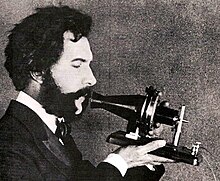
Actor portraying Alexander Graham Bell in a 1926 silent film. Shows Bell's first telephone transmitter (microphone), invented 1876 and first displayed at the Centennial Exposition, Philadelphia.
This history of the telephone chronicles the development of the electrical telephone, and includes a brief review of its predecessors.
Telephone prehistory
Invention of the telephone
Early telephone developments
Early commercial instruments
20th-century developments
Women's usage in the 20th century
21st-century developments
See also
References
Further reading
External links
Telephone
Alternative Title: telephony
Telephone, an instrument designed for the simultaneous transmission and reception of the human voice. The telephone is inexpensive, is simple to operate, and offers its users an immediate, personal type of communication that cannot be obtained through any other medium. As a result, it has become the most widely used telecommunications device in the world. Billions of telephones are in use around the world.
 Telephone
Telephone
- KEY PEOPLE
-
This article describes the functional components of the modern telephone and traces the historical development of the telephone instrument. In addition it describes the development of what is known as the public switched telephone network (PSTN). For discussion of broader technologies, see the articles telecommunications system and telecommunications media. For technologies related to the telephone, see the articles mobile telephone, videophone, fax and modem.
Alternative Title: telephony
Telephone, an instrument designed for the simultaneous transmission and reception of the human voice. The telephone is inexpensive, is simple to operate, and offers its users an immediate, personal type of communication that cannot be obtained through any other medium. As a result, it has become the most widely used telecommunications device in the world. Billions of telephones are in use around the world.

Telephone
- KEY PEOPLE
This article describes the functional components of the modern telephone and traces the historical development of the telephone instrument. In addition it describes the development of what is known as the public switched telephone network (PSTN). For discussion of broader technologies, see the articles telecommunications system and telecommunications media. For technologies related to the telephone, see the articles mobile telephone, videophone, fax and modem.
The Telephone Instrument
The word telephone, from the Greek roots tēle, “far,” and phonē, “sound,” was applied as early as the late 17th century to the string telephone familiar to children, and it was later used to refer to the megaphone and the speaking tube, but in modern usage it refers solely to electrical devices derived from the inventions of Alexander Graham Bell and others. Within 20 years of the 1876 Bell patent, the telephone instrument, as modified by Thomas Watson, Emil Berliner, Thomas Edison, and others, acquired a functional design that has not changed fundamentally in more than a century. Since the invention of the transistor in 1947, metal wiring and other heavy hardware have been replaced by lightweight and compact microcircuitry. Advances in electronics have improved the performance of the basic design, and they also have allowed the introduction of a number of “smart” features such as automatic redialing, call-number identification, wireless transmission, and visual data display. Such advances supplement, but do not replace, the basic telephone design. That design is described in this section, as is the remarkable history of the telephone’s development, from the earliest experimental devices to the modern digital instrument.
The word telephone, from the Greek roots tēle, “far,” and phonē, “sound,” was applied as early as the late 17th century to the string telephone familiar to children, and it was later used to refer to the megaphone and the speaking tube, but in modern usage it refers solely to electrical devices derived from the inventions of Alexander Graham Bell and others. Within 20 years of the 1876 Bell patent, the telephone instrument, as modified by Thomas Watson, Emil Berliner, Thomas Edison, and others, acquired a functional design that has not changed fundamentally in more than a century. Since the invention of the transistor in 1947, metal wiring and other heavy hardware have been replaced by lightweight and compact microcircuitry. Advances in electronics have improved the performance of the basic design, and they also have allowed the introduction of a number of “smart” features such as automatic redialing, call-number identification, wireless transmission, and visual data display. Such advances supplement, but do not replace, the basic telephone design. That design is described in this section, as is the remarkable history of the telephone’s development, from the earliest experimental devices to the modern digital instrument.
Power source
Switch hook
Dialer
Ringer
Transmitter
Receiver
Anti-sidetone circuit
Development of the telephone instrument
Early sound transmitters
Gray and Bell: the transmission of speech
The first devices
The search for a successful transmitter
Development of the modern instrument
Cordless telephones
Personal communication systems
Working components of the telephone
As it has since its early years, the telephone instrument is made up of the following functional components: a power source, a switch hook, a dialer, a ringer, a transmitter, a receiver, and an anti-sidetone circuit. These components are described in turn below.
As it has since its early years, the telephone instrument is made up of the following functional components: a power source, a switch hook, a dialer, a ringer, a transmitter, a receiver, and an anti-sidetone circuit. These components are described in turn below.

















No comments:
Post a Comment